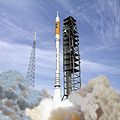Датотека:Aiaa2.jpg
Appearance

Veličina ovog prikaza: 600 × 600 piksela. 2 druge rezolucije: 240 × 240 piksela | 639 × 639 piksela.
Originalna datoteka (639 × 639 piksela, veličina datoteke: 84 kB, MIME tip: image/jpeg)
Istorija datoteke
Kliknite na datum/vreme da biste videli tadašnju verziju datoteke.
| Datum/vreme | Minijatura | Dimenzije | Korisnik | Komentar | |
|---|---|---|---|---|---|
| trenutna | 16:18, 3. novembar 2008. |  | 639 × 639 (84 kB) | Aaaf-wiki~commonswiki | {{Information |Description={{en|1=JSC2008e039697, 2008 - The Ares I Crew Launch Vehicle is being developed at Marshall Space Flight Center in Huntsville, Alabama, and is a two-stage vehicle designed solely for carrying the Orion CEV to Earth orbit. The 9 |
Upotreba datoteke
Sledeća stranica koristi ovu datoteku:
Globalna upotreba datoteke
Drugi vikiji koji koriste ovu datoteku:
- Upotreba na ar.wikipedia.org
- Upotreba na de.wikipedia.org
- Upotreba na en.wikipedia.org
- Upotreba na he.wikipedia.org
- Upotreba na hr.wikipedia.org
- Upotreba na nl.wikipedia.org
- Upotreba na nl.wikinews.org
- Upotreba na no.wikipedia.org
- Upotreba na ru.wikipedia.org
- Upotreba na tr.wikipedia.org


